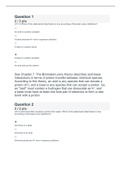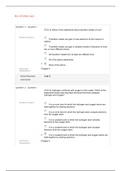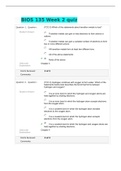Bios 135 week 3 quiz Study guides, Class notes & Summaries
Looking for the best study guides, study notes and summaries about Bios 135 week 3 quiz? On this page you'll find 10 study documents about Bios 135 week 3 quiz.
All 10 results
Sort by

-
BIOS 135 Week 3 Quiz (Multiple Choice & Short Questions) | Download To Score An A
- Exam (elaborations) • 2 pages • 2022
-
- $10.99
- + learn more
1. Question : (TCO 4) Ammonia (NH3) accepts a proton from water. Which of the statements listed below is true according to Bronsted-Lowry definitions? Student Answer: Ammonia is a base. Ammonia is an acid. Ammonia produces H+ ions in aqueous solutions. Ammonia acts as a solvent. Ammonia is neutral. Instructor Chapter 7 Explanation: Points Received: 2 of 2 Comments: Question 2. Question : (TCO 4) An unknown solution has a pH of 8. This solution is Student Answer: extremely acidic. moderately acid...

-
BIOS 135 Week 3 Quiz (Latest Version) Questions with Answers: DeVry University, Chicago
- Exam (elaborations) • 13 pages • 2022
-
- $14.00
- + learn more
Question 1 2 / 2 pts (CO 3) Which of the statements listed below is true according to Bronsted-Lowry definitions? An acid is a proton acceptor. A base produces H+ ions in aqueous solutions. A base is a proton donor. Correct! A base is a proton acceptor. An acid acts as the solvent. See Chapter 7. The Brønsted-Lowry theory describes acid-base interactions in terms of proton transfer between chemical species. According to this theory, an acid is any species...

-
BIOS 135 Week 3 Quiz (Latest Version) Questions with Answers.
- Exam (elaborations) • 13 pages • 2021
-
- $15.40
- + learn more
Question 1 2 / 2 pts (CO 3) Which of the statements listed below is true according to Bronsted-Lowry definitions? An acid is a proton acceptor. A base produces H+ ions in aqueous solutions. A base is a proton donor. Correct! A base is a proton acceptor. An acid acts as the solvent. See Chapter 7. The Brønsted-Lowry theory describes acid-base interactions in terms of proton transfer between chemical species. According to this theory, an acid is any species...

-
BIOS-135 Week 2 Quiz (Multiple Choice & Short Questions)/ 100% Guaranteed Pass
- Exam (elaborations) • 2 pages • 2022
-
- $10.99
- + learn more
1. Question : (TCO 3) Which of the statements about transition metals is false? Student Answer: Transition metals can gain or lose electrons to form anions or cations. Transition metals can gain a variable number of electrons to form two or more different anions. All transition metals form at least two different ions. All of the above statements are false. All of the above statements are true. Instructor Chapter 4 Explanation: Points Received: 0 of 2 Comments: Question 2. Question : (TCO 3) When...

-
Grad BIOS 135 Week 2 quiz e Details - All Questions
- Exam (elaborations) • 5 pages • 2022
-
- $12.49
- + learn more
Grading Summary Grad BIOS 135 Week 2 quiz e Details - All Questions Question 1. Question : (TCO 3) Which of the statements about transition metals is true? Student Answer: Transition metals can gain or lose electrons to form anions or cations. Transition metals can gain a variable number of electrons to form two or more different anions. All transition metals form at least two different ions. All of the above statements None of the above Instructo...

-
Grad BIOS 135 Week 2 quiz e Details - All Questions
- Exam (elaborations) • 5 pages • 2022
-
- $12.49
- + learn more
Grading Summary Grad BIOS 135 Week 2 quiz e Details - All Questions Question 1. Question : (TCO 3) Which of the statements about transition metals is true? Student Answer: Transition metals can gain or lose electrons to form anions or cations. Transition metals can gain a variable number of electrons to form two or more different anions. All transition metals form at least two different ions. All of the above statements None of the above Instructo...
BIOS 135 Week 2 quiz

-
BIOS 135 Week 2 quiz
- Exam (elaborations) • 5 pages • 2021
-
- $9.00
- + learn more
Grad BIOS 135 Week 2 quiz e Details - All Questions Question 1. Question : (TCO 3) Which of the statements about transition metals is true? Student Answer: Transition metals can gain or lose electrons to form anions or cations. Transition metals can gain a variable number of electrons to form two or more different anions. All transition metals form at least two different ions. All of the above statements None of the above Instructor Explanation: Ch...

-
BIOS-135 Week 2 Quiz
- Study guide • 6 pages • 2020
-
- $11.49
- + learn more
BIOS-135 Week 2 Quiz (MCQs & Short Questions)-Bios 135 Week 2 quiz Grading Summary Question 1. Question : (TCO 3) Which of the statements about transition metals is true? Student Answer: Transition metals can gain or lose electrons to form anions or cations. Transition metals can gain a variable number of electrons to form two or more different anions. All transition metals form at least two different ions. All of the above statements None of the above Instru...

-
BIOS-135 Week 2 Quiz-Questions and Answers
- Exam (elaborations) • 6 pages • 2020
-
- $7.49
- + learn more
BIOS-135 Week 2 Quiz-Questions and Answers/Bios 135 Week 2 quiz Grading Summary Question 1. Question : (TCO 3) Which of the statements about transition metals is true? Student Answer: Transition metals can gain or lose electrons to form anions or cations. Transition metals can gain a variable number of electrons to form two or more different anions. All transition metals form at least two different ions. All of the above statements None of the above Instructo...

$6.50 for your textbook summary multiplied by 100 fellow students... Do the math: that's a lot of money! Don't be a thief of your own wallet and start uploading yours now. Discover all about earning on Stuvia



